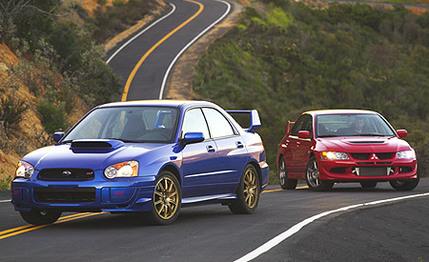
 Comparison Tests
Comparison Tests
To most folks, the Evo and the STi look absurd. That's because these small economy sedans have been tarted up with improbable—some dare say juvenile—bits and pieces of racy-looking gear. In this fashion, they will be familiar to much of America as variations on the slammed Honda Civic theme.
And indeed, the Subaru Impreza WRX STi and the Mitsubishi Lancer Evolution are performance cars that lack the voluptuous curves and tight muscularity most people associate with sporting cars in the $30,000 range. If the level of juvenile appeal can be measured by the height of an economy sedan's rear wing, then these two sedans are positively infantile.
But Subaru and Mitsubishi insist that the add-ons are fully functional and integral to the performance of these cars. The Evo's big carbon-fiber wing is claimed to reduce rear-end lift at high speed. And Subaru says the STi's absurdly tall and conspicuous hood scoop is necessary to feed the intercooler that sits atop the flat-four engine. We believe it. The height and shape of the scoop is effective as an industrial-strength bug killer, with hapless insects sucked in by the swarm and severed on the intercooler's fins. Also, the shape makes it perfect for use as a skateboard ramp. It could be used as temporary shelter for a diminutive immigrant family. (Every morning we'd awake to find several people pacing impatiently under the scoop's cover, waiting for a bus.)
This is all part of the appeal. These rally-inspired road cars—with which Europe and Japan are already thoroughly familiar after more than a decade of availability—are, in a sense, the newest and most-exciting class of performance cars to enter the U.S. market in years. Face it: To the latest generation of hot rodders, Mustangs and Camaros just ain't cuttin' it.
These are the new status symbols of performance. In fact, for those who do not aspire to own Corvettes, they are the anti-status-symbol status symbols. These are cars for the initiated—for those of you who stay up to watch the sideways glory of World Rally Championship coverage on the Speed Channel, and for those who choose to race the rally stages on Sony PlayStation's Gran Turismo. If the graybeards feel silly driving them, that's all the better.
A brief history lesson. It was Subaru that popularized this whole idea of selling economy sedans with punchy turbocharged motors and all-wheel drive to Americans. The car was the standard WRX, which we've anointed as a 10Best winner in each of its two years on the U.S. market. Mitsubishi's initial response was the decidedly lame Lancer O-Z Racing Rally Edition. With its punk 120 horsepower and front-wheel drive, it could no more be a genuine performance car than a drag queen could be your mother—the equipment was all wrong. Mitsubishi bridged the gap to some degree with the 160-hp Ralliart Lancer. Finally, Mitsubishi introduced the Evolution to this country at the Los Angeles auto show last January. The company basked in the adoring glow of the Evo's 44-hp advantage over the WRX—for all of one week. Then Subaru dropped its surprise 300-hp bomb on the awestruck at the Detroit show—days later in January—in the form of the STi model (for the company's in-house tuner, Subaru Tecnica International). One Mitsubishi official was seen seizing his crotch in mock pain over the blow dealt by Subaru.
It is for now, and for the foreseeable future, a class of two. The cars pictured here are both hot off the car-show stage and on sale as you read this. Certainly, we anticipate that some shoppers in this class would also consider the purchase of a Nissan 350Z, Mazda RX-8, or possibly the upcoming all-wheel-drive, V-6-powered Volkswagen Golf R32—particularly since they're in roughly the same price ballpark.
But the ante to play in this test consists of all-wheel drive, meaty near-slick tires mounted on lightweight aluminum wheels, highly turbocharged four-cylinder engines, and beefed-up econosedan brawn.
Still not convinced of the legitimacy of these Asian hot rods? Consider that one of our testers quite rightly concluded after a hard point-and-squirt run on a tight country road in Southern California that he couldn't have gone through the section any faster if he'd been in a Ferrari 360 Modena. How's that for absurd, old man?